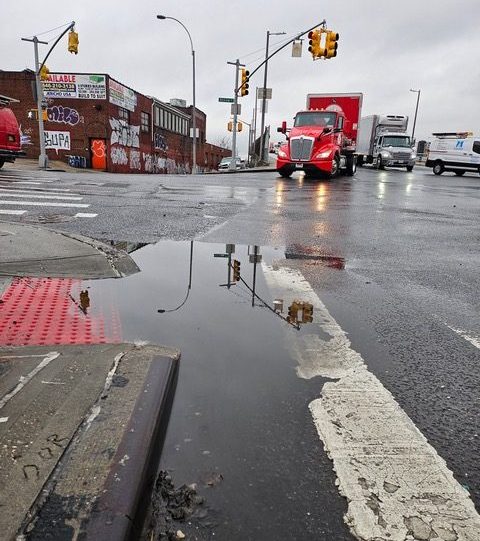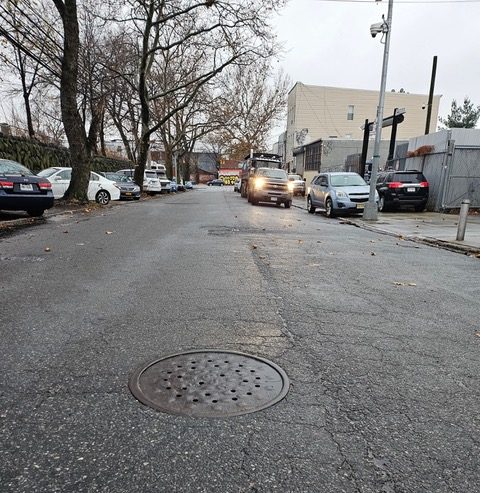
A flooded street curb during a rainstorm in Blissville where residents complain of chronic sewage backups and sewer drainage issues. Photo Neela Jain
Jan. 3, 2025 By Neela Jain
Blissville resident Thomas Mituzas plans his life around the rain.
Mituzas has a special weather app on his phone that lets him know when rain is on its way. He and his neighbors also have a WhatsApp group that they use to alert each other to check their homes’ drains during rainstorms.
Amid the autobody shops, wholesale distributors, and industrial businesses that define Blissville—a manufacturing zone in Long Island City nestled south of the Long Island Expressway and flanked by the sprawling 365-acre Calvary Cemetery and Newtown Creek—Mituzas’ home has endured persistent sewage backups over the past two years – eight according to his count.
He estimates that he’s spent at least $18,000 securing his home from future backups, including installing a special sump pump– a device that removes water from a basement or other low-lying area of a building and pumps it outside. “Like literally 5,000 gallons of raw sewage in the basement,” he said. “So now the backups don’t happen to me anymore. But I know it could happen if I didn’t protect myself,” he added.
Mituzas, who has lived in Blissville his entire life, and others in the small 1,100-resident community, approximately half of whom reside in the area’s 3 homeless shelters, say their repeated pleas to the city for help have been ignored.

A sewer manhole on 37th Street in Blissville where residents complain of chronic sewer backups in homes and businesses. Photo Neela Jain
Citing sewage backups as the area’s most pressing issue, residents say Blissville is plagued by multiple environmental infrastructure challenges that have become more apparent due to climate change. These include flooding due to storm surge events and air and water pollution associated with combined sewer overflows along Newtown Creek.
New York City saw a 32% increase in confirmed sewer backup complaints from July 1, 2023 to June 30, 2024, attributed to a 54% increase in rainfall, according to the Mayor’s Management Report.
In 2023, the city experienced five rainstorms that produced roughly 1.75 inches of rain per hour – tempests known as five-year storms because they are so big they have a 20% chance of occurring in a given year. The current rain capacity of Queens’ sewer network is 1.5 inches of rain per hour.
Extensive investment, including years of planning, decades of construction and tens of billions of dollars would be required to develop a stormwater management system that meets the demands of climate change, according to a report released in 2024 by the city’s Department of Environmental Protection.
Mituzas, who serves as secretary of the Blissville Civic Association and is a member of Queens Community Board 2, is frustrated by the lack of official communication from DEP. He said that while he has been told by workers from DEP that his street’s sewer measures only eight inches in diameter, smaller than standard for the area, he has yet to receive an official response from DEP identifying the cause of the sewage backups and a plan for mitigation.
“The workers aren’t afraid of telling me what’s going on. But getting a real answer out of DEP?” he said. “Someone just needs to tell us what’s going on,” he added.
Kevin Crowley Jr. has similarly struggled with Blissville’s sewage problems. He works at Fire Foe, a local fire safety equipment and services provider, and said the business has experienced at least six sewage backups in the past two years.
“Our building is right at the corner where the two sewer system drains are and once it starts raining hard, you can see them struggling to keep up,” he said.
On multiple other occasions, Crowley said, nearby sewer backups have flooded the sidewalks with inches of water.
Crowley said the sewage backups interrupt day-to-day business operations, forcing employees to sanitize and clean. “Getting the smell out, too, is pretty disgusting,” he said.
Warren Davis, president of the Blissville Civic Association and a member of Queens Community Board 2 alongside Mituzas, said the Board has been asking for a meeting with DEP nearly monthly, including requesting DEP’s attendance at an upcoming community board meeting. He said board members have also expressed their concerns to local elected officials like New York City Council Member Julie Won and U.S. Rep. Nydia Velazquez, who are trying to facilitate a meeting with DEP.
Davis, a 23-year resident of Blissville, cited the neighborhood’s manufacturing zoning status as one reason for the city’s lack of attention.
“Commercial areas get little love, if any. When you think it’s just a commercial area with no one living there, it’s at the bottom of the list for many electeds or other people,” he said.
At a December 12th DEP public presentation to reduce combined sewer overflows in Newtown Creek, Mituzas asked DEP for a meeting date. In response, DEP said that while it is aware of the sewage backups, it does not have a date set for the meeting but intends to meet with the Blissville community by February.
DEP did not respond to a formal request for comment.
In early December, the City Council approved a bill that required DEP to update its sewer backup prevention plan for 2025. Modifications include timely notice and explanation of unconfirmed sewer backups to impacted parties, as well as identification of areas with high incidences of damage due to sewer backups.
